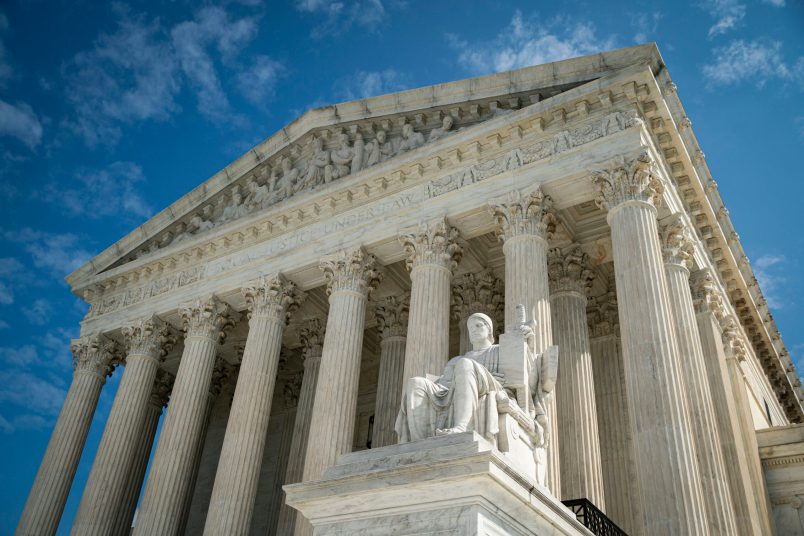This article is part of TPM Cafe, TPM’s home for opinion and news analysis.
Last month, Democrats in Congress introduced a bill to add four new seats to the U.S. Supreme Court — a once-fringe idea that has now fully entered the mainstream.
The Judiciary Act—introduced by Sen. Ed Markey (D-MA) and Reps. Hank Johnson (D-GA), Jerry Nadler (D-NY) and Mondaire Jones (D-NY) — is fundamentally about restoring balance to a highly partisan Supreme Court.
After a conservative takeover of our courts by former President Donald Trump and then-Senate Majority Leader Mitch McConnell (R-KY), the introduction of this bill marks an important moment in the fight to unrig the judiciary.
Today’s Supreme Court is radically unbalanced, with a conservative supermajority that does not reflect our country’s politics or diversity. In fact, a majority of the justices are older, wealthy, straight white males — and a majority were appointed by presidents who lost the national popular vote.
The degradation of our nation’s highest court has led to dozens of decisions in which far-right activist judges legislated from the bench to advance Republican priorities, like in 2010 when this unrepresentative Court ruled in Citizens United v. FEC that corporations could spend unlimited sums of money to influence our elections. Or in 2013 when they declared in Shelby County v. Holder that the most important civil rights law in U.S. history was unnecessary and unconstitutional.
In the years ahead, with six of nine justices having been appointed by Republican presidents, this unbalanced Court threatens to dismantle voting rights, roll back health care protections, cut gun regulations, change the status quo on women’s reproductive health, and block any progress made by the Biden-Harris administration on a host of other critical issues.
But to rebalance the Court, it’s key to remember that there is nothing magical about having nine justices, nor is it required by the Constitution.
While the current Court has nine members, when the U.S. Supreme Court first convened in 1790, there were only six justices. More recently in 2016, McConnell effectively brought the number of justices down to eight when he refused to let then-President Barack Obama appoint Merrick Garland (who is now President Biden’s attorney general) to the Court.
Congress can and has changed the size of the Supreme Court seven times, usually so that the number of justices equaled the number of federal appellate courts. Today, there are thirteen appellate courts—and the Judiciary Act would thus follow precedent and increase the total number of justices to thirteen.
While there’s been much debate over this kind of court expansion, the politics behind court expansion have shifted dramatically in recent years.
For decades, Republican voters cared more about the courts than Democrats and Independents. In 2016, Trump supporters were 8 points more likely than Clinton supporters to say Supreme Court appointments were “very important” to their vote. But then Trump nominated three justices to the Supreme Court, and we lost the iconic Justice Ruth Bader Ginsburg. By 2020, Biden supporters were more likely than Trump supporters to say the Court was an important issue for them. Moreover, some polls already show a majority of Americans support court expansion.
With Democrats in control of Congress and the White House, progressives are no longer willing to stand idly by while the Supreme Court’s right-wing justices gut progressive legislation or block the Biden-Harris agenda — and they’ll continue to push both the Biden administration and Democratic lawmakers to expand the court.
While some worry that if Democrats add seats to the bench, Republicans will do the same if they regain control of Congress and the White House, these fears ignore the permanent damage the Republican Party has already done to the Court and its reputation.
In 2016, Republicans proved that they’re only willing to confirm new justices to the Court when a president of their own party is doing the nominating.
The following year, Republicans eliminated the 60-vote threshold for Supreme Court nominees — a move that paved the way for deeply unqualified, even more conservative justices like Neil Gorsuch and Brett Kavanaugh to be confirmed with less than 54 votes in the Senate.
And just last year, McConnell defied Ruth Bader Ginsburg’s dying wish — that the next president should appoint her replacement — by packing the court with Amy Coney Barrett, yet another unqualified, uber-conservative, just eight days before the 2020 election.
Although the Biden-Harris administration recently announced a commission to research court reforms, if they truly want to reduce the temperature and stop Republicans from boiling away the independence of our courts, then expansion may be the only solution to depoliticize and restore trust in the Court.
It’s time for action on court reform, and for the Biden White House and Democratic leaders to realize the only way to get things done is to restore balance on the highest Court.
Brett Edkins is the Political Director at Stand Up America. He is a graduate of Yale Law School who clerked in the Southern District of New York.







Appropriate a $10 million cash pension payable to every justice upon their retirement. Problem solved.
There are 20 months left of control of both houses of congress. Drive. It. Like. You. Stole. It.
The only problem here is that if the Party of Trump gets control of the presidency and the congress in the future they would expand the Court to 21, and make sure that every appointee was a 30-something believer in Q.
So they can do that anyway.
We might as well beat them to it and get things done.
Word!
That’s what the Republicans believe already.